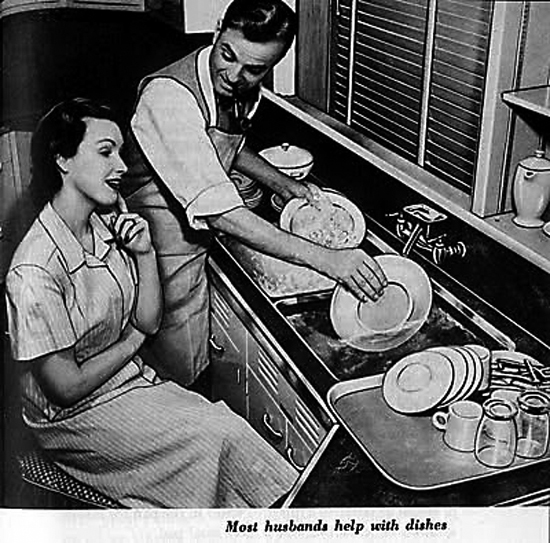
“What do you mean … I have to put dinner away when I do dishes? That’s can’t be an ‘implied’ rule, I don’t see that written down anywhere.”
And the pot containing cooked No. 3 spaghetti noodles mixed with sauce sat on the clean stove. The rest of the dishes were washed and air-drying while the former Marine just stood there with a smirk on his face.
Really?? Oh, he ain’t gonna like me …
I’m a rather fair technical writer. I wrote early video editing manuals at DeVry in 1985, then a few extremely detailed NAVAIR calibration procedures while in the Navy before moving on to assisting in the technical editing and some authoring of Microsoft Access and Visual Basic programming books for Wrox Press. So I can write me some techie stuff.
What’s he’d inadvertantly triggered was a Standard Operating Procedure for dishwashing at home. It took a few hours to nail down this morning based on what I’ve bitc … er … complained about in the past. But I do believe it’s all there. If not, there shall be revisions.
DISHWASHING STANDARD OPERATING PROCEDURE
last updated June 30, 20141. Dishes should be washed each evening. 48 hours from the last washing is an outside time limit to prevent insect infestations, odors, and other issues.
2. Collect all dirty dishes from the living room and bedrooms. Stack dishes to the right of the sink. (If stacking also on the rangetop, first ensure the elements are turned off and cool to touch.)
3. Put the previous meal away, throwing away food as needed (i.e., if the food will not store well, such as cooked pasta without sauce). Ensure there are no open containers in the refrigerator. If there are, fix the problem as needed, asking for recommendations if necessary.
4. Put away the clean dishes from the last washing, stacking largest on the bottom to smallest on top, keeping pieces together, such as lids to travel mugs, grease catcher in the electric griddle, etc. If you don’t know where something goes or how it’s stored, ask.
5. Change the drying cloths, the wash cloth and scrubbing sponge you’ll be using, and any drying towels, putting the older ones in the laundry.
6. Clean the sink bowls with hottest possible water to touch, and dish soap if necessary.
7. Stop the right sink, add hottest possible water to touch till 2″ from the top (deep wash water distributes foodstuffs better), adding 2 tablespoons dishsoap halfway through.
8. Wash the drain rack and its drain surface in the right sink first, along with the counter underneath, rinsing the drain rack and its surface in the left sink under hottest possible running water to touch.
WARNING: WASH KNIVES AND OTHER SHARPS INDIVIDUALLY,
NEVER DROPPING THEM INTO THE WATER
TO BE SEARCHED FOR LATER.
9. Wash dishes individually in the right sink, checking all surfaces, soaking only when necessary.
10. Check the inside of the microwave and wash the glass plate if necessary.
11. Rinse dishes in the left sink under hottest possible running water to touch.
12. Stack rinsed dishes in a safe manner, keeping pieces together, such as lids to travel mugs, grease catcher in the electric griddle, etc.
13. While washing, if more room is needed to continue stacking dishes in a safe manner in the dish drainer and on the drying towel space, towel-dry and put away the clean dishes, stacking largest on the bottom to smallest on top, keeping pieces together, such as lids to travel mugs, grease catcher in the electric griddle, etc. If you don’t know where something goes or how it’s stored, ask.
14. While final dishes are soaking in hot soapy water, clean the inside of the microwave (including the ceiling and carousel), rinsing with a hot and wet dishcloth that’s been rinsed of dishsoap. Reassemble the microwave with the glass plate and carousel and close the door.
15. Clean the rangetop with hot soapy water, rinsing with a hot and wet dishcloth that’s been rinsed of dishsoap. This includes lifting the elements (first ensure they’re turned off and cool to touch) and cleaning the drip bowls.
16. Clean all counters and backsplashes with hot soapy water, rinsing with a hot and wet dishcloth that’s been rinsed of dishsoap, including under appliances, cutting boards, etc., and corners.
17. Clean the table with hot soapy water, rinsing with a hot and wet dishcloth that’s been rinsed of dishsoap.
18. Finish washing, rinsing and stacking any dishes left to soak. NOTE: There should be zero dishes left soaking at this point.
19. Drain both sink bowls, putting rinsed and clean drain stops upside down on the back of the sink top. Clean the sink bowls, faucet and faucet area with hottest possible water to touch, and dish soap if necessary, rinsing with a hot and wet dishcloth that’s been rinsed of dishsoap.
20. Rinse dishcloths and scrubbing sponges in running hottest possible water. Wring out and lay out dishcloths to dry. Wring out scrubbing sponges and place on the back of the sink top next to the clean drain stops.
21. If the Keurig was unplugged, plug it in and turn it on. Ensure water tank is filled to the Fill line, and if it isn’t, fill it and reattach it to the Keurig with the lid on correctly.
22. Take the garbage out (including items next to the trash can, and any trash in the bathroom trash basket). Put a new trash bag in the trash can correctly for use and place the lid correctly.
Me: Well, whadaya think?
Ryan: I’m still reading …
Me: You hate me, don’t you?
Ryan: I’m still reading …
Yeah, they don’t like very much, do they? Meanwhile, Mary and I are still laughing.